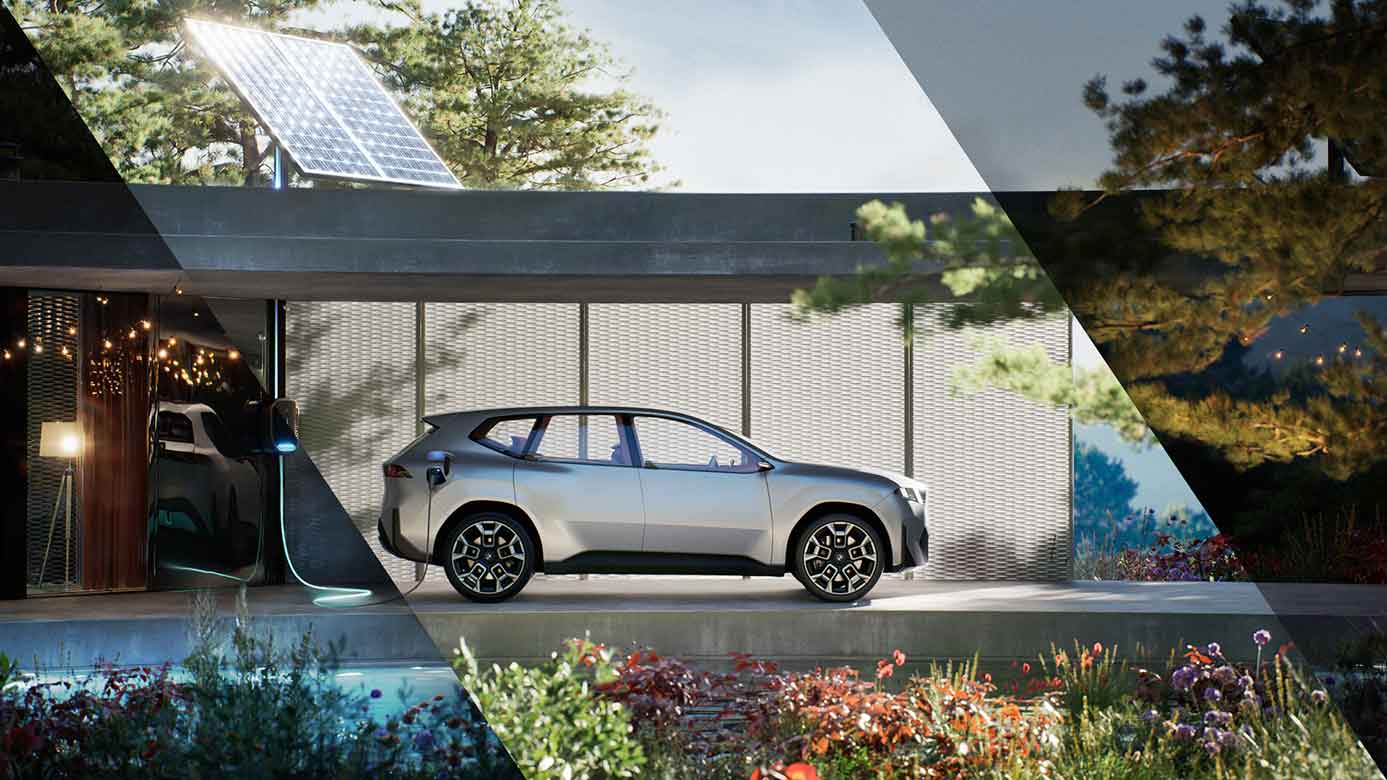21.03.2024
+++ Bidirectional charging comes with Neue Klasse models +++ Next technology boost focuses on intelligent charging +++ New functions for the charging ecosystem BMW Connected Home Charging +++
Munich. BMW Neue Klasse models scheduled for launch in 2025 will be able to store electricity and function as a power outlet. They are equipped with technology for bidirectional charging – i.e. the ability to both accept and supply electricity.
With the latest design studies, the BMW Vision Neue Klasse sedan and the BMW Vision Neue Klasse X SAV, the BMW Group is showing what the next generation of core vehicles from the BMW brand will look like. They represent the range of technological innovations with which the company is showcasing its future viability.
With the world premiere of the BMW Vision Neue Klasse X, BMW is now announcing another innovation set to enter production: the ability to charge bidirectionally. This technology makes it possible to use the high-voltage battery of an all-electric vehicle as an energy storage device and to return the cached electricity to either your own household supply or the power grid at a later stage.
This makes it even easier for BMW customers to actively contribute to the energy transition and promotes the sustainable generation and use of renewable energy. Functions such as “Vehicle to Home”, “Vehicle to Grid” and “Vehicle to Load” will therefore be available to BMW customers for the first time. This move also underlines the ongoing expansion of the BMW Group Charging offer.
“We are constantly improving our range of charging products and services in order to maximise the benefit to the customer,” says Frank Weber, member of the Board of Management of BMW AG, responsible for Development. “Starting this summer, we will be offering cost-optimised charging together with our partner E.ON in a number of markets. And with the Neue Klasse we will be taking the next step: bidirectional charging. Vehicle to Home and Vehicle to Grid, all fully integrated into our comprehensive charging ecosystem – BMW Connected Home Charging. Using the vehicle, the My BMW App, the BMW backend – plus a BMW DC Wallbox Professional and their photovoltaic system, customers will be able to control the energy flow in such a way that home charging is possible off grid at times. And, of course, they will also be able to lower their charging costs by feeding the electricity stored in their BMW back into the power grid.”
Vehicle to Home: electricity for your household
In the technology’s initial stage, bidirectional charging will enable customers to essentially use their vehicle’s high-voltage battery as a stationary energy storage device. Here, the carbon-neutral electricity generated by the customer’s photovoltaic system is temporarily stored in the vehicle’s battery with the help of the BMW DC Wallbox Professional and then subsequently fed back to power other consumers in the home, making the customer independent from the external power grid for a time and reducing their energy costs.
Vehicle to Grid: feeding into the network
The second stage of bidirectional charging will allow customers to make a portion of their battery’s capacity available externally. This energy capacity can be used for both charging from the grid and discharging electricity into it at appropriate times. Access to the energy market is provided by BMW cooperation partner E.ON. To do this, customers will need the dynamic electricity tariff from E.ON, who will manage the charging process together with the BMW backend to enable revenue generation from the energy exchange.
This function will only become available in the various markets once the necessary regulatory measures have been adopted.
Vehicle to Load: the car as a power bank
The vehicle to Load function allows energy stored in the vehicle to be used for powering external electrical equipment. This means the Neue Klasse can double as a form of mobile power bank for charging an e-bike, for example, or supplying energy to electrical equipment while camping.
Regardless of which type of bidirectional charging is used, the customer’s desire for mobility always comes first. This is ensured by intuitive and easy operation in the My BMW App, which can be used to control the entire BMW Connected Home Charging ecosystem.
Accelerating the energy transition
Bidirectional charging not only ensures greater supply security. By both accepting and supplying electricity, electric vehicles can make a significant contribution to the share of electricity consumption coming from renewable sources. Using the storage capacities provided by high-voltage batteries allows supply and demand in the area of green electricity to be better coordinated. For example, electric vehicle storage systems can selectively absorb peak wind and solar energy generation and release the electricity again during periods of low generation (night, lulls) in supply. This makes it possible to reduce the start-up of fossil power plants and their emissions during such periods. In this way, electric mobility is becoming an ever more integral part of the energy revolution. With bidirectional charging, CO2 emissions can be reduced both in the area of mobility and in power generation overall.



